
11-16 May 2022. So to continue the story from the last instalment, on May 11th we stumble around getting packed and ready to travel. Today’s the day we go to Split on the high-speed ferry. It’s a catamaran that bounces and lurches across the water, stopping at three of Croatia’s famous islands of the Dalmatian Coast along the way. We are still recovering from food poisoning so can do without the lurching, but still, it’s a travel day that goes smoothly – a taxi to Dubrovnik’s port, then the ferry to Split. None of us are eating anything more than crackers and watered-down juice, though L says she feels well enough to try a meal. There is no meal to be had.
The ferry from Dubrovnik to Split takes over four hours. It’s much like being on a bus except that we can at least get up and walk around. I’ll do a bit of conflating here – we take the same ferry back ten days later when we’re all fully recovered and can eat and drink whatever we want. There is still no meal to be had.
The concession stands on the ferry are dire. Chips. Candy. Beer. Appalling coffee. Even more appalling sandwiches. First-world problems I know, but it’s puzzling since they’d probably do well selling something more substantial.
From Don’s notes: Time seems to stretch out at times like this. It’s been 19:00 for hours, and we’re still only at 19:49. Still nothing, apart from eternity, lasts forever, so eventually we’ll get to Split, take a taxi to our accommodation, and think about having something to eat, maybe. We have no specific plans for our first few days in Split. So much will depend upon how we’re all feeling. The ferry has made three island stops so far, and there might even be a fourth. The time has finally clicked over to 20:00. The ferry wastes no time at each stop, just in, unload, load, then off we go again.
The big attractions in Split are the waterfront, the Old Town, and Diocletian’s Palace which dates back almost two thousand years, but I’ll get to those later. First I want to introduce you to ordinary Split, this lovely European city that is home to 180,000 people, the Split where people live and work, both in the main tourist areas and away from them.
We climb Marjan Hill. It’s a twenty minute walk from our apartment to the beginning of the path, then, after a thirty-minute climb that includes nearly 300 steps 
we reach, thankfully, a small cafe for a cold drink. And views of the city: a landscape of blue upon blue upon blue.
Split is guarded at its back by the Mosor Mountains, and flows down to the cerulean Adriatic Sea.
It curls around a safe harbour, and the top of Marjan Hill offers us views of the UNESCO core of the city and beyond. It shows us a city that begins with the red-tiled roofs of the historic Old Town, this nucleus that attracts so many visitors. Up against the waterfront promenade we can see the remains of the huge palace and fortress built almost 2000 years ago as a retirement home for Diocletian, Emperor of Rome. We can also see that beyond this the city gently morphs into a modern city of high-rises up against the mountains; a city of ordinary people.
It’s pretty much a straight shot from our apartment down a main road to the above mentioned waterfront, Old Town, and the ancient Roman buildings, but we rarely take it, instead preferring to explore the tiny cobblestoned streets and lanes that take us through an older part of town, but not so old that it’s a tourist attraction. Here I photograph the narrow streets lined by stone buildings, still fascinated by them, not having spent enough time in Europe to have become jaded. I’ve heard tell of those who have seen so many of Europe’s great cathedrals that they have become blasé about them – seen one cathedral seen ‘em all. I’m not there yet.

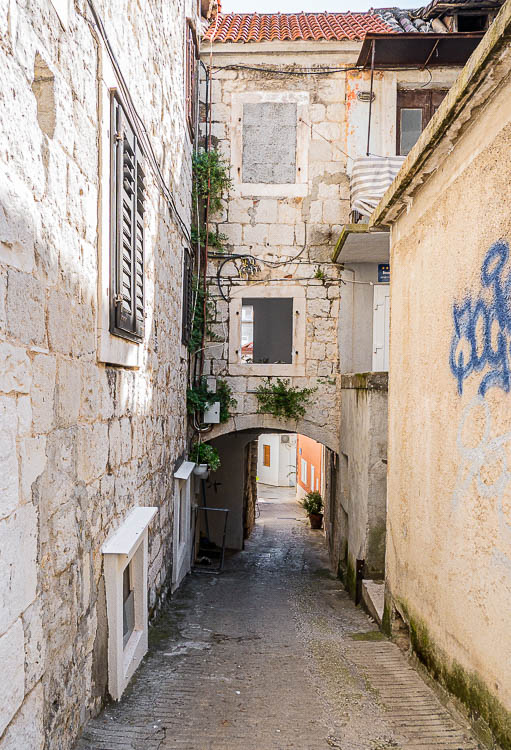
I photograph just about every sighting of laundry; it’s often about the colours; I love bright colours. And it’s always because it tells me about life here. Laundry is about ordinary people living in what to me is extraordinary housing, but still doing familiar things; a reminder that we are basically the same the world over – family, meals, laughter, tears, birth, death, laundry.




And here, laundry above, toys below. An entire family in one small image.
This is inner Split, fairly close to the main tourist attractions. Further out of course is the modern city, with the more prosaic housing that we would expect to find in most countries.

Which brings me to this: almost every day in Croatia I think of Ukraine – how the people of Ukraine were quietly going about their lives when suddenly, without warning, ordinary life ended. Bombs. Destruction. Heartbreaking loss. It’s almost as if I’m somehow walking the streets of Ukrainian cities, a sense that this is what it would have been like before the invasion. I can’t comprehend such fear and devastation. It makes me silently weep inside.
And yet here I am, walking the safe and quiet streets of Split, blessed beyond measure, passing by the ubiquitous cumquat trees, gardens in pots,
small green spaces,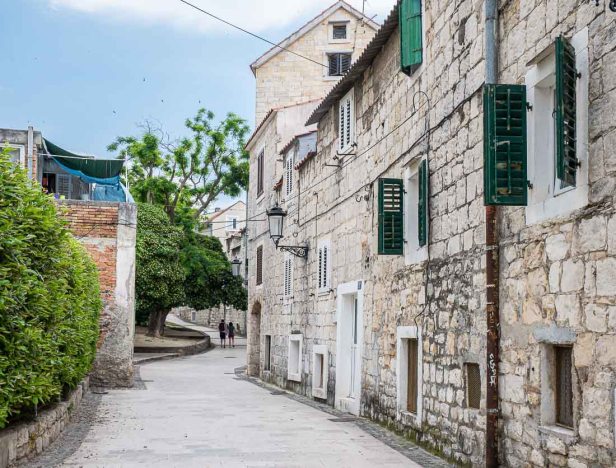
and street art on Radunica Ulica honouring two of Croatia’s, of Split’s, greatest stars. At the rear is Oliver Dragojević (1947-2018) a beloved musician, and riding the bike is Jurica Jerković (1950-2019), an equally beloved footballer.
Some days we pass the market, another favourite place to experience the mundane, the place where the people of inner Split shop for fruit and vegetables, plants for the garden, cheese, and all manner of bottled products. I watch the interactions taking place in this slice of daily life, and chat with stall holders even if sometimes we only understand a smile.
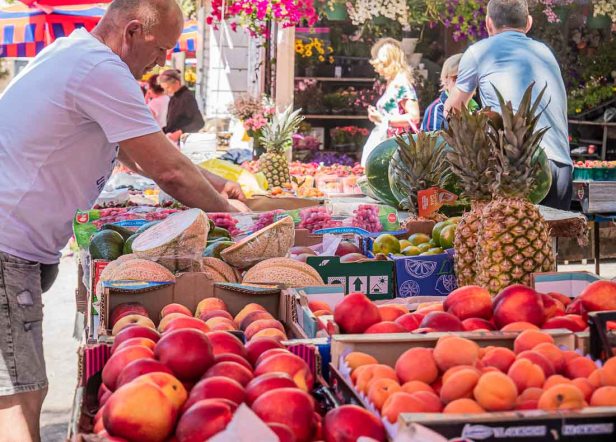
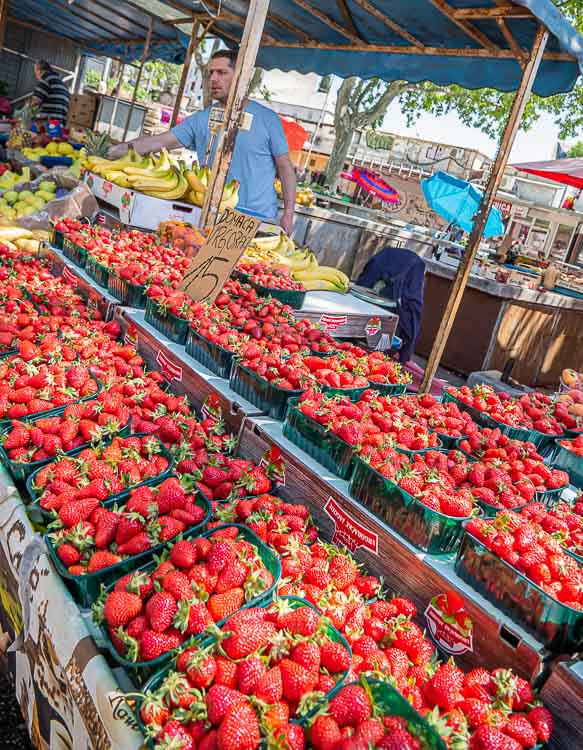



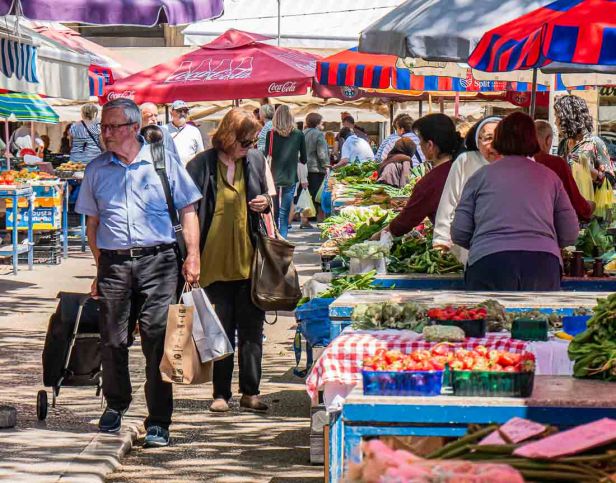






Most days we end up at Josipa Jurja Strossmayera Park.
On one day there’s a small festival with pop-up craft and food booths, and a group of special-needs people who are all taking turns to sing, their joy and sense of accomplishment making me smile. They are having so much fun.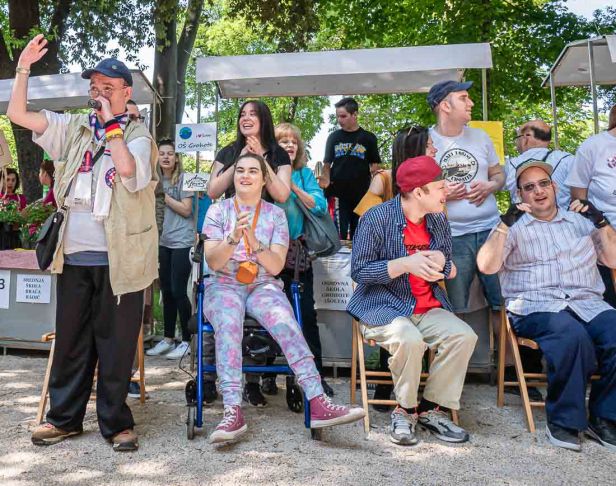
Just beyond the park, and before you get to the imposing Golden Gate entrance to Diocletian’s Palace and the Old Town there’s a statue. At 28 feet (8.5 metres) tall this towering monument to one of Croatia’s national heroes, is of Gregory of Nin (Grgur Ninski).
Nin was the Medieval capital of Croatia, and Gregory was the bishop. In 926 he defied the Catholic Church in Rome and started giving sermons in Croatian instead of Latin. Thus he became an important figure for Croatians and is regarded as an historical defender of their culture and language. It is believed to bring good luck to rub Nin’s left big toe, which is the only part of the entire gargantuan statue that is bright shining golden from so much polishing. Of course I give it a rub. One should never turn down the opportunity to attract good luck!
Leaving Marjan Hill and Strossmayera Park, leaving the Palace and the Old Town, leaving Tourist Central with its row of restaurants, leaving the glittering waterfront promenade, we walk back to our apartment the same way we came, along the winding pathways running through the local neighbourhood, past the stone houses built long ago that are the homes of the ordinary people that live in this city by the sea.
And at the end of the day with the lowering sun the streets also are golden. 
Next post will be a dive into Diocletian’s Palace and the Old Town, then the true star of Split – the waterfront. After that more blue water as we explore the islands of Hvar, Vis, and Brac.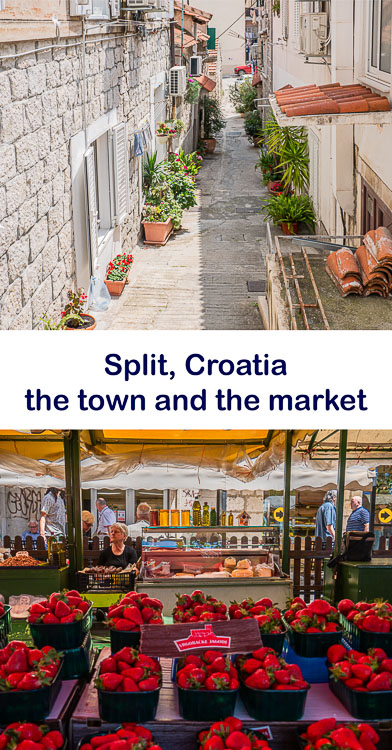
All words and images by Alison Louise Armstrong unless otherwise noted
© Alison Louise Armstrong and Adventures in Wonderland – a pilgrimage of the heart, 2010-2022.

I really love all the small streets. Wonderful picture, Alison.
LikeLiked by 1 person
Thanks so much rabirius. I do so love exploring the small streets of Europe.
Alison
LikeLiked by 1 person
So many wonderful scenes, but the laundry, market and golden hour shining on the stone houses and narrow alleyway are my favourite.
LikeLiked by 1 person
Thanks so much Vicki. You’ve chosen some of my faves too. I think I’ve photographed laundry and markets in just about every country I’ve been to. And the alley in the golden light is def a fave.
Alison
LikeLiked by 1 person
I never realized Split was this beautiful! Those mountains in the background only make this city even more appealing. No one does candid photos of the local people like you, Alison. Can’t wait to read more about this part of Croatia in your upcoming post!
LikeLiked by 1 person
Thank you so much Bama. People are one of my fave things to photograph. Split is really beautiful as you can see. Everywhere we went on the Dalmatian coast was just gorgeous.
Alison
LikeLiked by 1 person
I think markets are such a wonderful way to see the real people, both the vendors and the shoppers. Those strawberries look amazing. I have lived in Europe for 7 years now and I still find something unique and interesting about every cathedral, castle and village I encounter.
LikeLiked by 1 person
I love exploring the local markets. If you’ve only got a short time in a place they’re one of the best ways to experience a slice of authentic local life. Oh yes, it was strawberry season! We ate a lot of them 😂
We visited several other Croatian villages and like you I was fascinated with them all – each has something unique to offer. And then we went to Greece and found something quite different again. I do look forward to seeing more of Europe. And I hope I never become jaded.
Alison
LikeLiked by 1 person
Love the smiling lady in the red frock. So true that this is an everyday scene that has been torn away from them in Ukraine. Sad beyond words. 💗💗
LikeLiked by 1 person
Thanks so much Jo. She was such a sweetheart.
I thought of Ukraine every day. It was just so clear that I was walking in a place that could just as easily have been there. Heartbreaking 😢
Alison
LikeLiked by 1 person
I had no idea that split was so beautiful. I love those first shots in your post with the panoramic view of the city. I also enjoy the smiling faces in your photos. We still have to wear masks here in Taiwan and I miss seeing smiles!!!
LikeLiked by 1 person
Thanks so much Jeff. I didn’t know you were still wearing masks in Taiwan. I too would miss smiles after all this time. 😟
I did enjoy my time at the market, and at the little festival in the park, interacting with the local people – it’s so easy to connect even when you don’t have the language.
As I said to Bama, everywhere we went on the Dalmatian coast was gorgeous. It’s a very beautiful part of the world. And this isn’t even the prettiest part of the city – I’ll do a post on the waterfront promenade soon, which is absolutely lovely.
Alison
LikeLike
All interesting, Alison, with your usual flair for photos. The part that made me smile was rubbing the toe, however. It’s always a tale-tale sign of people seeking good luck when you find a statue with rubbed parts, whether it is the nose of a pig or the toe of a holy man. 🙂
LikeLiked by 1 person
Thanks so much Curt, glad you enjoyed.
You can be sure that toe was well rubbed! 😂 Probably because it was so easily reachable.
Alison
LikeLike
I wonder if it cures gout. 🙂 I haven’t had it in a long time, but there were a few times that my big toe would have loved a gout-curing toe. 🙂
LikeLiked by 1 person
Stunning photographs and intriguing writing, as usual! I love wandering the narrow streets of eastern Europe just like you – main drags are so often somewhat overrated and commercial. I’ve traveled all of the countries surrounding Croatia (except Serbia), but somehow, never Croatia itself. I’ll have to add it to the list! I can’t wait to travel again…
LikeLiked by 1 person
Thank you so much Whitney. I agree about main drags – too many people and too much tourist tat – and then just a short walk away the streets are empty and authentic and so intriguing.
I hope you get to Croatia one day! It’s so beautiful.
Alison
LikeLike
There is so much eye candy in this post, I don’t think I’d be able to pick a favorite photo! It’s clear you had a great time going off the beaten track and exploring more untouristed parts of Split. I so love the snapshots of ordinary people living their lives, and the narrow streets with stone-built houses and splashes of greenery. The neighborhood market overflowing with colorful fruits, flowers, and jars of olive oil almost seems to jump out from the screen. And of course I appreciated the historical tidbits with anecdotes about interesting figures like Gregory of Nin (no curses this time though)!
LikeLiked by 1 person
Thanks James! 🤗 I’m glad you enjoyed my pics. It was fun taking them – looking for s’thing authentic, and different angles. Aren’t those jars of olive oil (and other colourful liquids like cherry brandy!) beautiful!
I’m never satisfied with seeing only the main tourist sites, as I’m sure you’ve gathered by now, so all this was a rewarding exploration. More historical tidbits to come – Diocletian was quite the dude!
Alison
LikeLiked by 1 person
Loved Split. The laundry photos are so fun!
LikeLiked by 1 person
Thanks Ruth. We too loved Split. A lovely vibe there.
Alison
LikeLiked by 1 person
Great street photography series, Alison.
LikeLiked by 1 person
Thanks so much rabirius. 🙏👍
Alison
LikeLike
The hike up the hill reminds me of a hike I did above the hills outside of Zurich, looking down at an Old Town surrounded by a modern town, with the blue blue lake and mountains beyond. Yet the stone alleys remind me of Malta, and the market of the Galapagos Islands. A real trip down memory lane!
I’m looking forward to the post about the Palace!!
LikeLiked by 1 person
I’m so glad I brought back so many good memories for you!
I had no idea there would be such a market on the Galapagos. It’s pretty obvious really since there are towns there, but being on a cruise they didn’t really register.
Many of the European Old Towns must look pretty similar from above I would think.
Alison
LikeLike
I can really see your love for humanity here, Alison. There are so many interesting scenes and views…and I really like the bookending of that gorgeous evening image at the beginning and the final image, with people slowly trudging up that hill.
The view from the top of that hill is wonderful – and it doesn’t look hazy or polluted, nice! The laundry is fun to see and all that pale stone behind it is special, too. It’s a very nice introduction to everyday Split!
LikeLiked by 1 person
Thanks so much Lynn. We enjoyed Split. It didn’t quite have the same wow factor as Dubrovnik, but still had plenty to offer. I do love to see how people live in places that are so different from what I am used to (and so much the same). I think that final image is one of my faves, and yes – no pollution!
Alison
LikeLike
Great title and beautiful post about ordinary people.
LikeLiked by 1 person
Thank you so much. I’m glad you enjoyed it.
Alison
LikeLiked by 1 person
What a treat this was! I’ve been to Split, but, staying in the historical center, I never saw half of this. Makes me want to return and dig a little deeper!
LikeLiked by 1 person
Thanks so much Mo. I’m glad we stayed just a little out of the old town – about a 20 minute walk or so. The exploring was fun. Maybe you’ll get back one day!
Alison
LikeLiked by 1 person